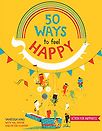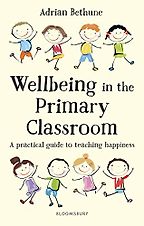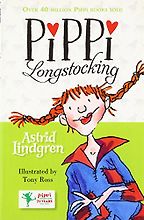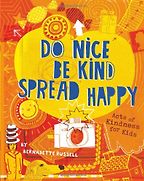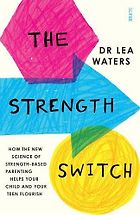Your recent book for children draws closely on and is directly linked with the work you have done as lead psychologist for Action for Happiness. Before we get into your book choices, can you tell me a bit more about that charity?
It was initiated by eminent economist Professor Lord Richard Layard of the London School of Economics, a long-time advocate of the need to change how we measure progress as a society. The primary measure used has traditionally been GDP per capita. Richard’s argument – which he wrote about in his 2005 book, Happiness: Lessons From A New Science – is that the measure of GDP is necessary but it’s not sufficient. If you look at trends in GDP per capita since the 1950s or 1970s (in the U.S. or Europe, depending on the dataset) the trend is upwards. On average we are getting richer, we have a lot more in a material sense, but if we look at evaluations of life satisfaction over a similar period, a key measure of happiness used by economists, that hasn’t increased and mental ill-health has increased. So, we’ve got richer but we haven’t got any happier. So people started to ask Richard, “What do we need to do to close this gap?”.
At the same time Richard was arguing this, the field of psychology was going through something of a revolution. An equally eminent figure, Dr Martin Seligman, who’d spent the majority of his career studying depression, realised that the majority of psychological research up to that point had primarily focused on illness and dysfunction – why things go wrong and how to treat or cure those – which of course is important, but there had been very little research into why things go right and how to spread that, in other words, what enables people to live happier, more flourishing lives. We get this from a physical health point of view, that not being ill is not the same as being at peak physical fitness, so what is the equivalent for psychological health? So at the turn of the millennium the need for a greater emphasis on the psychology of optimal functioning, wellbeing or “positive psychology” as it is known, was established. In the last 20 years, research in the field has grown exponentially and has been influential in neuroscience and other health research too.
“We’ve got richer but we haven’t got any happier”
Recognising that this new branch of psychology could help address the gap left by a singular focus on material growth, Richard, along with leading educationalist Sir Anthony Seldon and social innovator Geoff Mulgan, founded Action for Happiness as a social movement. Our mission is to inspire and support people to take action to proactively increase happiness and wellbeing for themselves, and in their communities, work places and schools. I’ve been involved since before we launched. My role in that is translating the latest psychological research into practical ideas for action that people can apply in their own lives and in the world around them.
I suppose, and I mean this without cynicism, that happier people are more productive? Do you think that including happiness skills in the way we bring up our children will have a positive effect on society as whole? Hence it being a subject of interest for economists?
There is a growing body of evidence to show that happiness is one input into a wide range of positive outcomes in life, not just an output from things going well. For example happier people tend to be physically healthier, they are less likely to catch colds or experience heart attacks and they are more emotionally resilient. There is also evidence that they can live longer. From a productivity point of view, happier people are more likely to be productive than unhappy people. For instance, doctors who are happy make faster and more accurate diagnoses; companies who pay attention to these ideas out-perform companies who don’t on the stock market. Happier people are also more likely to contribute to society in other ways. They are more likely to help others, they are less likely to engage in risky behaviours – for example on the road – and they are more likely to be financially responsible and vote. The list goes on. So it seems that feeling happy is not just a cherry on the cake of modern living, it has real personal and societal benefits. These findings make very compelling arguments for improving life satisfaction. It’s also about the sort of society we want to live in, and moreover with a growing and ageing population like the one we have, taking happiness or psychological wellbeing more seriously is increasingly important because it’s about prevention, not just cure.
Do you think that happiness, or mental ill-health, is more of a problem for current generations than it was in the past? Or is it more that people are more open about their emotional health than previous generations were able to be?
It’s a bit of both. We now have more diagnostic labels and language for mental ill-health conditions than we had in the past and we are increasingly able to talk about experiencing anxiety and depression. Because we are more aware of these things, more people will be presenting with the conditions.
“Happier people tend to be more physically and emotionally resilient – there is also evidence that they can live longer”
However society has also changed quite rapidly. Along with the focus we’ve had on material success, many of us don’t live near extended family groups anymore or feel connected to our communities. Life has sped up. We are bombarded by advertising offering its view of what makes a happier life, leading us to think “I’ll be happier when I have those shoes or that gadget”. Whilst those sorts of things can make a short term difference, they aren’t enough. Our wonderful technological advances give us access to information and ideas, but on the downside we are also much more aware of what other people seemingly have compared with ourselves (and it’s often inaccurate!) and this exerts pressure: “Am I the only one who doesn’t have three parties to go to this weekend?” These technological advances and tools are great for the democratisation of knowledge, but we haven’t learned how to use them sustainably. Our brains evolved to help survive as hunter-gatherers and they’ve not caught up for using smartphones or being online 24/7 – which we’ve only had for around 10 years – so it’s not surprising this can contribute to unhappiness. In the last five or so decades many of us have striven for one thing after another to get material success. I think the younger generation is kicking back a little against this idea.
Importantly, we aren’t educated to think about what really matters and we’re not taught skills that help us feel happier. If you ask most people what they ultimately want from life, or what they want for their children, most people will say they want to be happy, or want their children to have happy lives. But we don’t spend much time thinking about what that really means and what does it take in terms of our daily actions and behaviours.
What is happiness, exactly?
Good question! We often use the word liberally but as I said earlier we rarely think about what it really means and takes. We often think of happiness as a fleeting, emotional state. When I do workshops and ask people what they think happiness is, at first they say things like ‘chocolate’. But very quickly they come up with other, perhaps deeper things, such as being with family and friends, feeling fulfilled, content, feeling that they are making a difference, being creative and learning.
“We need some moments of pleasure to keep us moving forward towards our goals”
Ancient Greeks talk about two different sorts of happiness. Hedonia which is fleeting pleasure – it’s where the word hedonism comes from. Whilst you can have too much of a good thing, having some pleasure has been shown to be important. They also talked about Eudemonia, which translates roughly as a sense of fulfilment, of living a good life. In practice I believe we need a balance of both. When we are working hard to achieve things, that will ultimately contribute to living a good life – passing an exam, working hard in our jobs, bring up children or a project in our community – it doesn’t necessarily feel good at the time. We need some moments of pleasure to help keep us moving forward towards our goals. A happier life is a dynamic balance between pleasure, working towards a sense of eudemonic satisfaction, and being able to deal with the downs as well as the ups of life.
And this is one of the areas you deal with in your own book for children, written with co-authors Val Payne and Peter Harper, called, 50 Ways to Feel Happy: Fun Ideas and Activities to Build Your Happiness Skills.
In the book we explore what happiness is, why it’s important, and what we can do to help us to feel and stay happy. It’s packed full of fun activities to try and is peppered with happy facts from the science. It is aimed at children aged 7-11 years. The book is structured around the 10 Keys to Happier Living that I developed for Action for Happiness and they are also the focus of my first book for adults. The 10 Keys are important areas in which evidence shows we can take action to feel and be happier, and research is also showing lots of activities that make a difference. They are a menu, not a prescription, as we are all different and need different things at different times. The acronym for the 10 Keys is GREAT DREAM which many people seem to love and I hope will capture children’s imaginations.
The 10 Keys are a toolkit for ‘psychological sustainability’ for want of a better expression. Of course they aren’t a substitute for clinical help if we are really struggling, but science shows that these small activities can add up to making a real difference in our lives and help in sustaining our wellbeing.
“We human beings can be very good at disturbing ourselves”
Psychologically speaking, having a sense of control over our lives is really important. It doesn’t mean control over everything but knowing that there is something we can do or try makes a difference. If I have the tools to understand my feelings, maintain my wellbeing and, if I’m feeling down or having difficulties, know I am able to take steps to help myself feel happier, then I will not only cope better but enjoy life more. The keys to a happier life are also the keys to resilience. An important aspect of resilience is known as ‘active coping’ – so having a toolkit of ideas for what you can try really helps.
We human beings can be very good at disturbing ourselves. If we can recognise early on when we are ruminating, catastrophising or unhelpfully comparing ourselves to others, we are less likely to end up depressed or anxious. These tools and ideas help us help ourselves; there is something you can do. Importantly happiness is not just an individual pursuit. It’s a shared responsibility and caring about other people’s happiness can also boost our own. We explore this a lot in the book.
You are keen to see techniques for building happiness embedded in our schools and i family life. Can you tell me more about how you envisage this?
I believe we need to apply these ideas in both what and how we teach and apply them in a ‘whole-school’ approach. We can teach specific happiness and wellbeing skills as in classes currently teaching PSHE (Personal, social, health and economic). We can embed these ideas in other curricula. In literature classes, for example, you can highlight the strengths, values or type of emotional responses characters have. There is an application of it in our approach to learning, for instance, Carol Dweck’s work on “fixed and growth mindsets” is gaining traction in schools. Teacher and parent wellbeing is also a vital and often overlooked element. Our wellbeing is contagious and how happy teachers feel impacts their ability to teach well and affects the whole school community. Parent wellbeing of course has a knock-on impact on their children.
These ideas are important for everyone. Why wait until someone is depressed and anxious to teach them some of these ideas, why not teach them as life skills? Where better to start than in schools with the very young?
This leads quite nicely onto your first book choice, Wellbeing in the Primary Classroom: A Practical Guide to Teaching Happiness by Adrian Bethune – due for release in September 2018.
Adrian is a primary school teacher and active member of Action for Happiness. He has taken the 10 Keys to Happier Living and other ideas from positive psychology and applied them with great success in his classroom. This book shares that experience as a guide for other teachers.
Can you tell me more about Adrian’s specific approach and what makes this book stand out for you?
Adrian was an early adopter of Action for Happiness ideas. He felt that these could make a big difference in the school he worked in and has put them into practice in his own classrooms. For example, Anti-Bullying Week is something that a lot of schools participate in. But it highlights the negative behaviours rather than constructive ones. Instead Adrian introduced It’s Cool to Be Kind Week choosing to promote positive good, social evidence-based behaviours. The kids learned why kindness was important for everyone’s happiness and explored doing kind tasks over the week. For example they produced a newspaper of happy headlines and stories to hand out at the local train station which made commuters smile. The kids were tasked with doing kind things for people in their community, and several people wrote to the school with notes of thanks. It showed kids that they can have an influence and make a difference. This approach achieved everything Anti-Bullying Week could have and much, much more.
“They chose to promote positive good, social evidence-based behaviours instead of negative ones”
Adrian’s well-structured book shows teachers how to teach a range of concepts and skills and integrate them into the classroom and school culture. It’s one of the first books of its kind that makes it easy for teachers to understand why this matters and what they can do in a practical sense in their classrooms.
Your second choice, The Strength Switch by Dr. Lea Waters, is aimed at parents, isn’t it?
This is a really useful book for parents. Most parents want to help their children to be happy and grow into the best person they can be, but don’t get much clear guidance. This is one of the first books that shares ideas on how to embed “positive psychology” into parenting.
Dr. Waters talks about “negativity bias”. Could you tell me a bit more about this, where it comes from and perhaps why we should be aware of it?
In wanting to help their children make the best of themselves many parents, no matter how well-meaning, often end up being critical to their child and focusing on what they are doing wrong, rather than developing their child’s strengths and noticing what the child is doing right. This isn’t unique to parents, it’s an effect of the natural human tendency called the “negativity bias”. In parenting it can have a damaging effect if we aren’t aware of it and know how to navigate around it.
“As a result of our evolution our brains are attuned to notice what is wrong. We also tend to overlook what is right”
Our brain evolved when we were hunter-gatherers as I mentioned earlier, and so is hard-wired to notice signs of danger. Out there on the savannah hunting for food, we had to be finely tuned to potential risk in our environment, as these could be life-threatening. Even though life today is much, much safer for the most part, as a result of our evolution, our brains are still attuned to notice what is wrong. We experience bad emotions like fear more strongly and we hang on to unpleasant emotions for longer. We also tend to overlook what is right. Psychologists recognise that when it comes to our experience of emotions, ‘bad is stronger than good’. But it turns out that when we train our brains to notice what is right, as well as what is wrong, it has psychosocial and developmental benefits that impact how much we learn, the options we see, our relationships, resilience and wellbeing.
This book helps parents look at this potent tendency and gives tools to notice and nurture our child’s strengths. It’s not about ignoring weaker areas but about a more constructive, informed approach. So this clear, structured and practical book helps well-intentioned parents do their best better. And as we can also apply this negativity bias to ourselves and other aspects of our lives, this book can have benefits for parents themselves too!
Your third choice is fiction for children aged eight to twelve, War Horse by Michael Morpurgo.
I include this because it is an emotional story of love, resilience and meaning. It’s important that when we talk about happiness we don’t make the mistake of expecting life to always be perfect. All of us will experience difficulties, losses and challenges and the uncomfortable emotions that come with those are part of life. The science of wellbeing and building our happiness skills necessarily helps to build our ability to deal with tough times and bounce back too.
Get the weekly Five Books newsletter
This is also a favourite book of my eldest nephew, Alex. We went to see the play together and I bought him an illustrated version one Christmas which he took to a Show-and-Tell lesson when he was at primary school. The teacher liked it so she read it to the whole class during story time, and it was lovely to see his pride when he told me this! Introducing my nephews to new ideas, experiences and new worlds is something I personally find highly meaningful.
I find Michael Morpurgo a fascinating author for children. He is never afraid to tackle real depth of emotion in his work. I’ve noticed that my daughter (eight years old) craves his books – I have wondered if she needs them to allow, or help, her to explore some of her more complicated or melancholy emotions. This appears to be as important to her as expressing laughter.
I don’t want to give the impression that we should focus on happiness to the exclusion of other experiences. However, the psychology of wellbeing can help us recognise and get through the tough times.
“Reading can teach you how to think around a situation, it can teach courage and humour”
War Horse is a pretty hard-hitting story which puts its readers in touch with a breadth and depth of emotions. Life has ups and downs and it is normal and appropriate to feel anger, sadness and fear in response. That is important for children to realise. Research shows it’s helpful to have words for a wide range of emotions. The richer a child’s lexicon of emotions, the easier it is for them to understand specifically what they are experiencing, communicate it effectively and it seems to help them manage their emotion better too.
Reading about other people (and animals) experiencing difficulties also helps us feel and develop empathy and compassion, which are so vitally important in terms of societal and our own wellbeing. If we go through difficulties, there is reassurance in knowing others have experienced similar times too, that it’s not just us, which can lead to feeling isolated and alone.
Your fourth choice is another work of fiction for readers aged eight to ten: Pippi Longstocking by Astrid Lindgren
I loved this and the other Pippi books as a child. They were a favourite from my trips to the local library every Saturday morning. Pippi is simply joyful. She is curious and courageous, creative and kind. She doesn’t worry about the small things like matching stockings or tidy hair. She doesn’t blindly follow convention but is very much her own person. She makes mistakes but finds her way through them. Looking back she was perhaps an early female role model for me! She taught me early on that I don’t need to follow conventional paths. That’s the power of fiction.
Do you think that fiction is a good way to access meaningful lessons regarding happiness and resilience?
One of the ways we learn new ideas and build confidence in what we can do is through vicarious experience, and fiction is a great source of this. Reading can teach you how to think around a situation, see different approaches and it can give us courage to try them ourselves. Great lessons. In fact there’s a whole new academic field emerging from positive psychology, called ‘positive humanities’ which looks at the role of humanities in developing wellbeing.
Your last book choice is a lovely book to end our conversation on, Do Nice, Be Kind, Spread Happy: Acts of Kindness for Kids by Bernadette Russell. I found it such fun and very much enjoyed the mischievous quality in its Robin Hood-esque approach to kindness.
The first Key to Happier Living in the framework I developed for Action for Happiness is Giving – doing kind things for other people. It’s also the focus of the first chapter in 50 Ways to Feel Happy. Caring about and feeling connected to other people is an important ingredient in happiness.
I think kindness has evolved as a social glue, an important ingredient in creating a happier society. We know that in communities where there is a greater sense of trust and support there is also greater wellbeing. As well as contributing to another person’s happiness, being kind activates the reward centre in our own brains – it actually helps us to feel happy ourselves. We also know that happier people tend to help others more, so it’s a kind of virtuous circle if you like. This makes sense as we are a social species.
There are many different ways that we can help others and be kind. There are big things like charity runs but the small things can be hugely significant too. Something as simple as giving our attention or smiling at another person, or noticing when someone needs a helping hand. We are acutely sensitive to one another as human being especially to feelings of being cut off or excluded, so something as simple as these actions can have powerful impact. Knowing that helping can boost the giver’s wellbeing can also make it easier to ask for help. And we all need help from time to time! Being kind and helping others is also a great way of feeling that we are contributing to something beyond ourselves. Bernadette’s book is great for children who want to explore even more ideas around this.
Interview by Zoe Greaves
April 18, 2018. Updated: November 29, 2021
Five Books aims to keep its book recommendations and interviews up to date. If you are the interviewee and would like to update your choice of books (or even just what you say about them) please email us at [email protected]
Five Books interviews are expensive to produce. If you've enjoyed this interview, please support us by donating a small amount.

